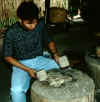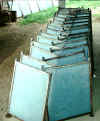Origin of Paper - Broussonetia papyrifera
Paper was invented by the Chinese about 2000 years ago. Although humans
had used other flat substances upon which to write, clay tablets, hide parchment, and
papyrus, from which we get the word paper, none of these are truly paper. Paper is
made of randomly oriented (a felt) plant fibers. According to contemporary records
of AD 105, "Under the reign of Emperor Hi-Ti, Ts'ai Lun of Lei-Yang conceived of the
idea of making paper from the bark of trees....The paper was then used throughout the
entire Universe." The tree was the paper mulberry, Broussonetia papyrifera.
Although today the vast majority of all our paper is made from wood fibers, this
paper was made from the bark, or bast, fibers. While not as cheap or as plentiful,
bast fibers are much easier to process.
The bark is striped from young branches and boiled until soft. The soggy
bark is then pounded to separate the fibers and remove softer tissues. The fibers
are then suspended in water. A layer of felted fibers is picked up on a screen and
dried to produce a sheet of paper.
In many places in Asia paper craftsmen continue to produce paper using these
centuries old techniques. In the following images, paper is being made for parasols
at a guild factory in northern Thailand not too far from Chiang Mai. The Chinese
called paper mulberry the Ku Tree; the Thai call it the Sa Tree.
 A young Sa Tree, paper mulberry, to show
the tourists. |
 Bark of the paper mulberry. |
 Pounding the boiled bark to separate the
fibers. |
 Felting the fibers using a silk screen. |

Row of paper on silk screens drying.
|
 Peeling the sheet of paper from the silk
screen. |
BACK to Course & Plant Photo Essay Page
BACK to Armstrong's Main Page





